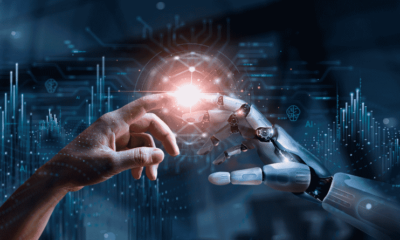
IBM has predicted that about 120 million jobs all over the world will have to be retrained within the subsequent 3 years, however, 50% of enterprises have zero skills development strategy in place. Companies are indeed under financial pressure to prepare for AI and automation and set up contingency plans for the transformation of their industries. However, considering the volume of resources that is necessary to prepare for this, it is important that they are also confident that whatever tools they deploy will actually enhance their commercial capabilities.
What is an Augmented Workforce?
The term “Augmented” does not necessarily relate to Artificial Intelligence. It can refer to any assistive system that enables employees to carry out their duties more efficiently and safely.
An augmented workforce typically describes a working arena wherein human employees work alongside intelligent virtual assistants or machines to achieve better outputs.
In the real sense, establishing an “Augmented Workforce” demands fresh strategies in addition to an internal culture set to welcome change.
Achieving Higher Value from Augmented Workforce
Through the integration of human capability with Artificial Intelligence, businesses will be able to increase productivity, while also ensuring maximum safety and reducing downtime of equipment. The shift to a workforce enabled by technological innovations and skills from the labor force equipped with conventional systems is considered to be one of the most effective approaches for enterprises, although this constitutes certain challenges to the trends of human capital.
The primary objective is to forma kind of symbiosis between the human workers and the machines. In order to attain this strategic height, businesses must reconceive business processes and employee roles to allow for collaboration between individuals and AI. This flawless fusion between individuals and machines is known as an “Augmented workforce”. The utilization of sophisticated warehouse technologies at Amazon, for instance, demonstrates how robotics, flexible human workforce strategies, and cognitive computing can function to achieve efficiency and drive enhanced productivity while adding manifold new hires. The e-commerce giant in a bid to satisfy skyrocketed demands during the holiday seasons increases its workforce by up to 40% with almost 120,000 temporary staff recruitment.
These new hires can quickly be trained by leveraging the use of cognitive and robotic technologies. The use of tools such as smart tape dispensers, automated training screens, and robotic pallets decreases the time required for training new workers at the organization from 6 weeks to as little as just 2 days.
Many companies make use of Artificial Intelligence for marketing automation, service, and support purposes by leveraging chatbots. These AI-powered solutions have the ability to respond to queries swiftly based on the keywords typed into the conversation by users, and also provide better customer service compared to a human staff that manages numerous conversations manually. As a result, these kinds of workforce innovations will not only add flexibility to workers but also increase jobs on the whole.
Guidelines for successful implementation of augmented workforce strategy
Based on our experience in deploying an augmented workforce strategy, we have identified below some core steps.
- Businesses must determine what strategic processes they should automate. Moreover, it is recommended that businesses establish an internal automation task force (comprising c-level executives, managers, and end-users) responsible for overseeing the implementation of the automation strategy.
- Consider all kinds of technologies that can assist in automating tasks. This should include AI, cognitive, and robotics technologies. Artificial Intelligence is not always the most ideal solution. Robotic Process Automation (RPA) can be the perfect solution to launch your “augmented workforce” strategy.
- Select which employees have to undergo upskilling or retraining. Based on your retraining strategy, it will be more seamless to identify which roles must be retrained.
- After identifying the stage where individuals and AI can function symbiotically, ensure that every stakeholder works and experiments collaboratively from the beginning. It is pertinent to ensure that human workers are completely on board with the AI/automation solution. If possible, it is recommended to have data experts and designers work together as early as possible to build user-friendly systems. Prior to and after deployment, evaluate how the solution is being by people and measure not only the productivity but also the qualitative elements of the experience.
- After the implementation of the initial automation tools, proceed to create a long-term strategic and annual operational workforce planning and roadmap. It is crucial to have an “augmented workforce” roadmap featuring various departments such as finance, procurement, IT, and HR.
Any automation strategy that fails to take human input into consideration will ultimately fail in no time. For Artificial Intelligence applications, leaving individuals out of the loop will hinder you from gaining access to an abundant source of expert knowledge and added value. To create an augmented workforce, it is essential for decision-makers to be investing in responsibilities and roles that are 3 to 5 years away.
4 Consideration When Pursuing Intelligent Automation for Higher Value and Productivity
Digital automation in its various forms has the capacity to contribute greatly to workplace productivity. The burning question is not whether automation can impact the workforce, but instead, how, to what extent, and at what stage will we attain the equilibrium between robotic and human employees.
Financial institutions in pursuant of the use of intelligent automation are urged to consider 4 key aspects during the transition:
-
Lead with vision
Many times, businesses are beginning with the technology and seeking to apply that technology to their business operations. However, intelligent automation is not concerned with replacing humans with technology or unraveling swift wins via a technology solution. Rather, companies have to adopt the end-to-end view, preparing a vision for completely new processes or customer experience, and then capitalizing on modern automation technologies to accomplish that vision.
-
Take the human component into consideration
In the development of an automation strategy, companies have to consider not only how IA will impact workforce capabilities and composition in years to come, but also what transition is necessary to meet the long-term organizational goals. To start with, transform speculations about future needs into workforce scenarios that can serve as a guide for decision-making. Core Aspects to consider are workforce recruiting and training needs, the balance between automation technologies and individuals, the organizational structure to support that balance, and compliance considerations.
-
Transparency is key
Transition management should be a top priority as your employees need to understand both the reason behind the transformation and the way forward. It is understandable that workers will perceive an automation strategy as a ticking time bomb for their job prospects, leading to wrong assumptions and ultimately resistance. Avoid feeding into this fear of theirs. Instead, you must be open about the reason for the changes, the potential effects it will have, and how your employees can make contributions to the transformation. This is particularly essential as you progress into more advanced automation strategies since machines must learn by studying humans as they complete tasks and make decisions.
-
Make an investment in human capital
The method by which companies handle the shift to a hybrid automated workforce will greatly determine their success. In the short term, businesses must supply employees with the skills and training they need to effectively get accustomed to and operate these new technologies as part of their regular duties. In the long run, the question becomes how to upskill people for new or evolving positions, or how to support them when they leave the company.
It’s crucial to remember that as the industry moves toward increased automation, it’s not an all-or-nothing situation: there’s no need to pick between an all-human or all-machine workforce. Organizations must instead look for methods to blend automated operations with legacy personnel processes in order to get the most value and productivity out of both types of resources.
The Role of HR in Workforce Automation
The job of HR will change dramatically in the coming years, and it will be the responsibility of HR officials to ensure that employees are adequately retrained. HR will impact how employees regard their companies for years to come, so getting it right will be critical to a company’s automation strategy. Furthermore, HR departments must guarantee that a positive and upskilling culture is created within the organization.
HR professionals should ensure that their employees see AI as a positive development that will help them rather than endanger their careers. While this may appear to be a daunting undertaking, maintaining an open and upfront conversation with employees about automation can build trust and check for any adjustments that may influence how they operate. Reskill, not simply upskill.
Augmented Worker: Use Case
A use case illustrating the strategic value of automation and augmented workforce may be seen below.
Amazon and machine learning
Amazon recently declared that one-third of its workers will be retrained to help mitigate the consequences of automation. This bold strategy consists of six initiatives that will be available to Amazon employees at every location.
Non-technical staff will be taught the skills needed to shift into software engineering careers at Amazon Technical Academy. Employees with a technical background will be able to develop machine learning skills at Learning University.
The augmented workforce of the future
After all, employees are on the same page, it’s time to decide how to incorporate an augmented workforce. Fractal science-based automation can recognize and analyze many forms of corporate data as part of an ‘Integrated Automation Platform’. This kind of automation significantly decreases the amount of human involvement required is typically manual tasks, thereby assisting firms in their digital transformation path.
Organizations from a variety of industries are likely to embrace intelligent automation based on fractal science, and it’s interesting to see what the future holds for companies that adopt this cutting-edge technology. Considering that the United Kingdom is presently testing retraining programs for employees who may be displaced as a result of automation, businesses should be hopeful that policymakers will listen to their concerns and effectively regulate the applications, instead of limiting their use by imposing a blanket regulation on the entire technology.
Final Thoughts
In conclusion, we believe that the future is bright for individuals who are prepared to learn new skills and work to either add to the job of an AI-powered solution, work alongside it, manage it, or do something they can’t do.
At that point, businesses will need to provide workers with the opportunity to not only upskill, but also reskill, so that they may take on higher-value tasks as well as completely new positions. People are 3 times more likely to work for a firm that offers them purpose, therefore adding value is one of the most crucial things for the modern worker. The first step in this process is to set clear expectations for what this reskilling would entail and be open about how it will impact the working lives of employees.








